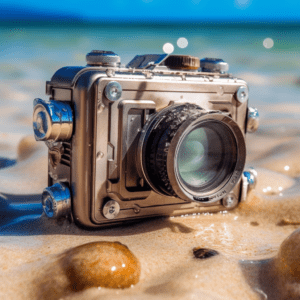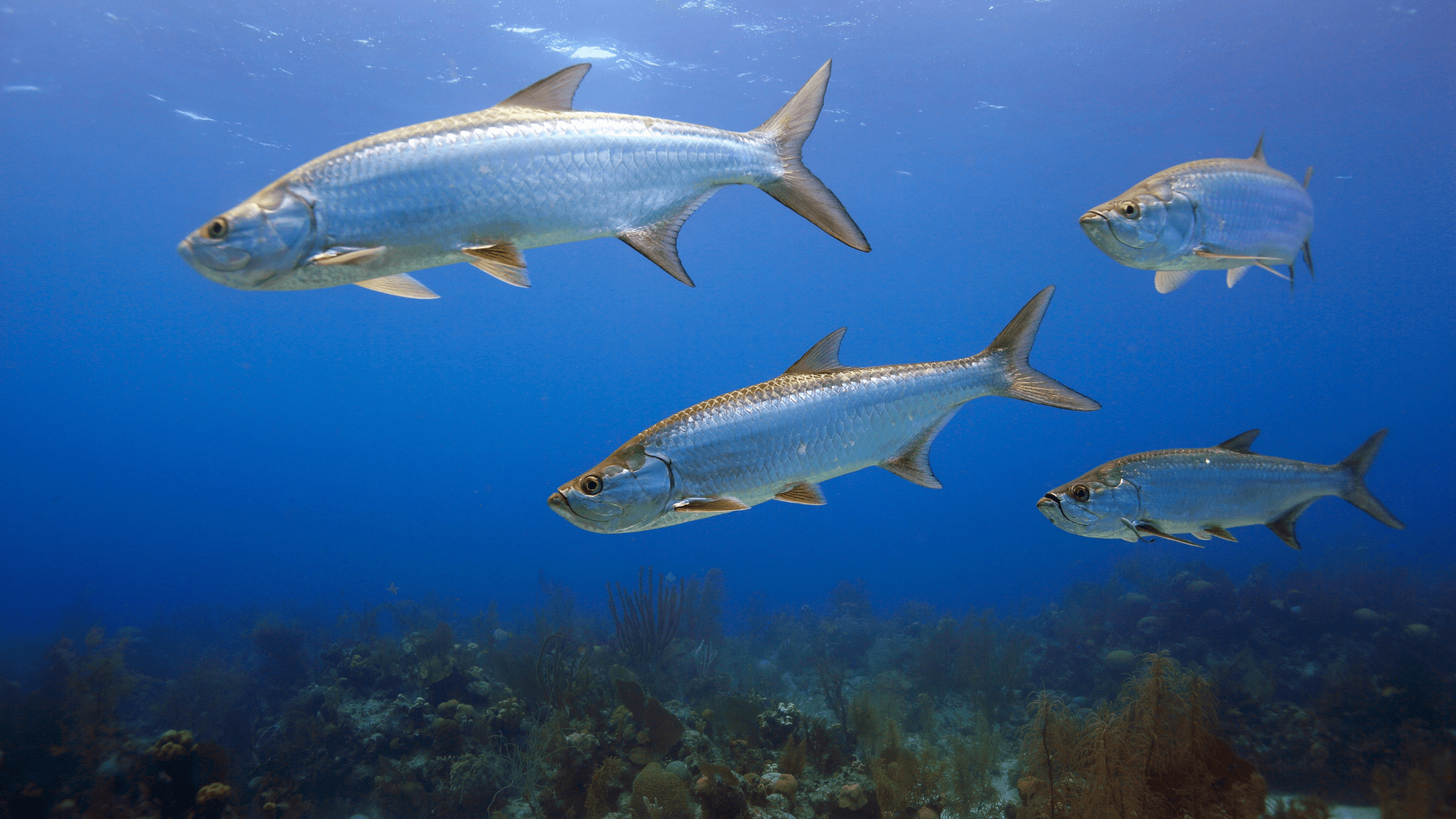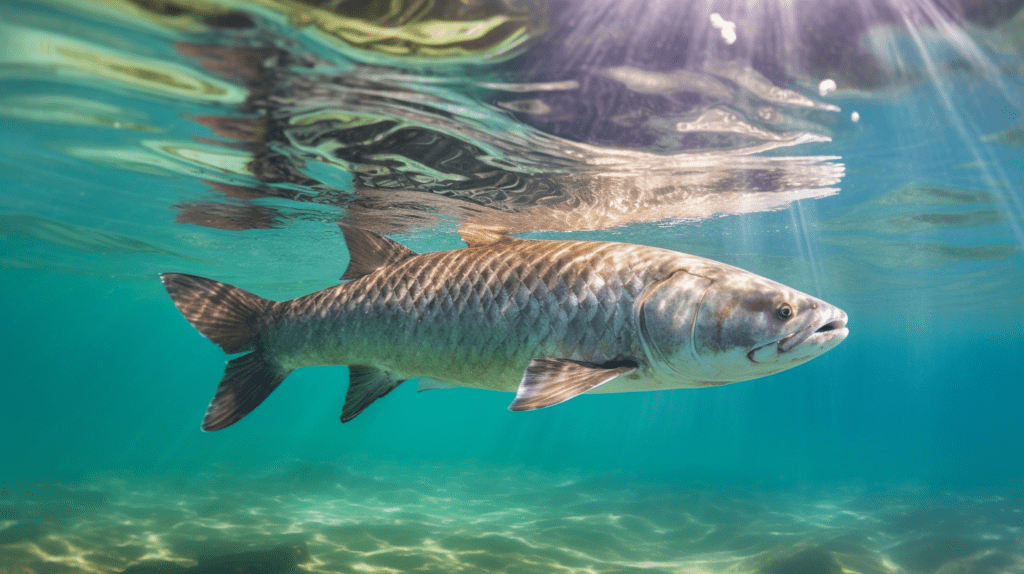Are you ready to dive into the world of underwater photography and capture the beauty of the tarpon? With its stunning scales, powerful body, and impressive size, this fish makes for a fascinating subject.
But before you can start snapping away, there are some important preparations and techniques you need to know.
Firstly, it’s essential to understand the basics of underwater photography. This type of photography requires specialized equipment and techniques that differ from traditional photography on land. You’ll need an underwater camera or housing that is designed to withstand water pressure and protect your gear from damage.
Additionally, you must learn how to properly balance light, adjust camera settings for different depths, and work with the unique challenges presented by water movement.
So grab your gear and get ready to explore the world beneath the surface as we dive into capturing the beauty of the tarpon through underwater photography.
- Key Takeaways
- Introduction to Underwater Photography
- The Tarpon: A Fascinating Subject
- Preparation for Underwater Photography
- Techniques for Capturing the Tarpon
- Post-Processing Tips
- Ethical Considerations
- Sharing Your Work
- Conclusion and Future Opportunities
-
Frequently Asked Questions
- What type of camera is recommended for underwater photography of tarpons?
- Are there any specific safety precautions that need to be taken while photographing tarpons underwater?
- What are some common mistakes that beginners make while photographing tarpons underwater?
- How can I improve my composition while photographing tarpons underwater?
- Are there any regulations or restrictions on underwater photography of tarpons?
Key Takeaways
- Underwater photography requires specialized equipment and techniques, with gear selection and proper preparation being crucial factors.
- Tarpons are a fascinating subject for underwater photography, exhibiting interesting behaviors in their natural habitat.
- Ethical considerations should be taken when photographing tarpons and other marine life species, with overfishing and habitat destruction being threats to their survival.
- Underwater photography can contribute to valuable data for conservation efforts, educate people about the importance of protecting marine life, and raise awareness for future generations.

Introduction to Underwater Photography
Ready to take a dive into the fascinating world of underwater photography and discover the stunning beauty that lies beneath the surface? Before you can start snapping pictures, it’s important to have the right camera equipment.
Underwater cameras are specially designed to capture images in water, with features like waterproof casing and specialized lenses. It’s also crucial to invest in quality lighting techniques, as light behaves differently underwater than on land.
When it comes to lighting, there are several options available. One popular method is strobe lighting, which can help add depth and contrast to your photos. Another option is continuous lighting, which provides a constant source of light for your subject. Regardless of which type you choose, be sure to experiment with different angles and distances to find what works best for the specific conditions you’re shooting in.
Once you have your camera equipment and lighting sorted out, it’s time to start exploring all that underwater photography has to offer! From vibrant coral reefs teeming with life to mysterious shipwrecks lurking in the depths, there’s no shortage of incredible sights waiting for you below the surface.
So now that you have a grasp on some of the basics of underwater photography, let’s dive deeper (pun intended) into one particularly fascinating subject: the tarpon.
The Tarpon: A Fascinating Subject
You’ll be amazed by the unique features of this fascinating creature, making it an ideal subject for your next underwater shoot.
The tarpon is a large, silver-colored fish that can grow up to 8 feet in length and weigh over 280 pounds. Its elongated body and large scales make it easily recognizable, but what makes this fish truly captivating are its behaviors.
To capture the beauty of the tarpon in your underwater photography, you’ll need to understand its behavior. Tarpons are known for their acrobatic jumps out of the water when hooked on a fishing line, but they also exhibit interesting behaviors while swimming freely in their natural habitat.
They often swim close to the surface of the water with their dorsal fin exposed, which makes them easier to spot and photograph.
Exploring the habitat where tarpons thrive will give you opportunities to photograph them interacting with other species. Tarpons live in saltwater environments such as estuaries and nearshore waters along beaches or coral reefs.
They share these habitats with other marine life such as stingrays, sharks, sea turtles and schools of smaller fish that they hunt as prey.
In order to successfully capture stunning images of these magnificent creatures, it’s important to be prepared before diving into their environment. From selecting appropriate equipment for underwater photography to understanding lighting conditions and camera settings – there are many factors that can make or break your shots.
Stay tuned to learn more about how you can prepare yourself for a successful underwater shoot!
Preparation for Underwater Photography
To get the best shots, it’s crucial to properly prepare yourself and your equipment before diving into the tarpon’s habitat. Gear selection is a key factor in underwater photography. You need to choose the right camera, lens, lighting, and housing that will suit your needs. As an underwater photographer, you should also be familiar with diving safety procedures and protocols to ensure your own safety while capturing the beauty of the tarpon.
Before going on your dive, make sure that all of your gear is in good working condition. Check all of your camera settings and lenses beforehand so that you can focus on getting great shots once you’re underwater. Your housing should be able to withstand water pressure at depths where tarpons reside. It’s important to note that even though you may have prepared well for a shoot, unexpected problems or issues can still arise in the field.
Table:
| Gear Selection | Diving Safety | Preparation |
|---|---|---|
| Camera | Buoyancy control | Check equipment |
| Lens | Dive buddy | Test camera |
| Lighting | Emergency plan | Adjust settings |
During the dive itself, pay close attention to any potential risks or dangers such as strong currents or entanglement hazards. Be aware of wildlife around you as some fish may become aggressive if they feel threatened or startled by divers nearby. Always have a dive buddy with you when shooting in case anything goes wrong.
In order to capture stunning photos of the tarpon swimming gracefully in their natural habitat, preparation is key. By selecting appropriate gear and adhering to proper diving safety protocols during shoots, photographers can focus on getting great photographs without worrying about unnecessary distractions or dangers while underwater. Next up: techniques for capturing these magnificent creatures!
Techniques for Capturing the Tarpon
Now that you’ve prepared your gear and familiarized yourself with diving safety procedures, it’s time to dive into the techniques for capturing tarpons in their natural habitat.
The tarpon is a majestic fish known for its silver scales, large eyes, and elongated body. Here are four tips to help you capture stunning images of this beauty:
- Shooting Angles: Experiment with different shooting angles to create unique perspectives of the tarpon. Try shooting from above or below the fish, or even from behind it. This will add depth and interest to your photos.
- Lighting Techniques: Proper lighting is crucial for underwater photography. Use natural light when possible, and avoid using flash as it can cause harsh shadows and reflections. If you must use artificial lighting, try diffusing the light source to soften its effect.
- Patience: Tarpons are fast swimmers and can be difficult to photograph at times. Be patient and wait for them to come closer before taking your shot.
- Timing: The best time to capture tarpon photos is during early morning or late afternoon when the sun is lower on the horizon. This provides softer lighting conditions that enhance the colors of both the fish and surrounding environment.
With these techniques in mind, you’ll be well on your way towards capturing breathtaking images of tarpons in their natural habitat.
To take your underwater photography skills even further, let’s move on to post-processing tips where we’ll discuss how to edit your images for maximum impact without sacrificing image quality or integrity.
Post-Processing Tips
Once you’ve taken your stunning shots of these magnificent creatures, it’s time to enhance them using post-processing tips that will bring out their natural beauty and showcase the underwater environment.
One of the most important post-processing techniques is color correction. Water can distort colors, leading to a blue or green cast in images. Adjusting white balance and exposure can help to correct this issue and bring back the true colors of the fish and surrounding environment.
Another important technique for enhancing your tarpon photos is cropping. Cropping allows you to focus on specific details or compositions within an image, creating a more impactful final product. When cropping underwater photos, it’s important to keep in mind that some areas may appear blurry or distorted due to water movement or low light conditions. Be sure to crop strategically so that these issues aren’t as noticeable.
In addition to color correction and cropping techniques, there are other post-processing tools available that can help improve your tarpon photos. These include adjusting contrast, saturation, sharpness, noise reduction, and more. Experiment with different settings until you find what works best for each individual photo.
Before moving on to ethical considerations when photographing tarpon and other marine life species, make sure you take full advantage of the many post-processing tools at your disposal. By correcting colors and utilizing effective cropping techniques, you’ll be able to create stunning images that truly capture the beauty of these incredible creatures in their natural habitat.
Ethical Considerations
Being respectful and mindful of marine life is crucial when taking photos in their natural habitat, as it allows us to appreciate and protect these creatures for generations to come. As underwater photographers, we have a responsibility to ensure that our actions do not harm marine life or their habitats. This involves following responsible photography practices such as not touching or disturbing the animals, avoiding sensitive areas, and using appropriate equipment.
Conservation efforts play a significant role in protecting the environment and its inhabitants. As photographers, we can contribute by supporting organizations that work towards preserving marine life and their ecosystems. By doing so, we can help ensure that future generations will continue to enjoy the beauty of nature. Additionally, it is essential to educate ourselves on sustainable fishing practices and avoid buying seafood from unsustainable sources.
When taking photos of tarpons or any other marine creature, it is important to remember that they are wild animals that deserve respect. Avoid chasing them or getting too close as this may cause stress or disrupt their natural behavior. It is also crucial to avoid using flash photography at night as this can temporarily blind them.
In conclusion, ethical considerations are an integral part of responsible underwater photography practices. Conservation efforts should be supported through education and awareness campaigns aimed at reducing human impact on the environment. Remembering these basic principles while capturing magnificent shots of tarpons will allow us not only to appreciate their beauty but also protect them for future generations. Sharing your work with others could inspire them to learn more about conservation efforts needed worldwide!
Sharing Your Work
You can inspire others to appreciate and protect marine life by sharing your stunning photos with the world. Social media sharing is an excellent way to showcase your work and get it in front of a broad audience. Platforms like Instagram, Facebook, and Twitter are ideal for displaying your underwater photography skills. By using relevant hashtags and geotags, you can reach people who share similar interests and build a following.
Portfolio building is another critical aspect of sharing your work as an underwater photographer. It helps potential clients evaluate your skills, experience, and unique style. A well-crafted portfolio should highlight only the best images from your collection that showcase exceptional lighting techniques, composition, colors, and perspectives. You can create a professional-looking portfolio on websites like Behance or Squarespace.
To help people enjoy your work better, consider writing accompanying captions that provide context about the subject matter or location where you took the photo. Also, try to tell a story with each image that captures the viewer’s attention and interest them in learning more about marine life conservation efforts.
Lastly, don’t forget to engage with your followers by responding to comments or direct messages promptly. Sharing your underwater photography work is not just about gaining likes or followers; it’s also about making meaningful connections with other photographers or conservationists passionate about preserving our oceans’ beauty.
By creating quality content consistently over time while staying true to yourself as an artist will ultimately lead to new opportunities such as collaborations with brands or publications interested in showcasing your work further.
As you wrap up this article on sharing underwater photography work through social media platforms like Instagram or building portfolios on sites such as Behance or Squarespace, remember there are many ways for you to continue growing in this field beyond what has been discussed so far today! Keep pushing forward towards new goals while always remaining respectful of marine life around us so we can preserve its natural wonder for generations yet unborn!

Conclusion and Future Opportunities
In conclusion, sharing your underwater photography work on social media and building a portfolio can lead to exciting future opportunities in the field of marine conservation. With the rise of visual storytelling, your images have the potential to reach a large audience and inspire others to care about tarpon conservation efforts. By showcasing your work, you may also attract the attention of organizations that are seeking photographers to document their research or conservation projects.
As technology advances, so does underwater photography equipment. New cameras and accessories allow for clearer images and better control over lighting conditions. This means that photographers can capture more detailed shots of tarpon behavior and habitat, which can be used as valuable data for conservation efforts. Additionally, advances in photo editing software give photographers more options for enhancing their images and creating visually stunning compositions.
The future looks bright for those interested in combining their passion for photography with marine conservation efforts. There are various ways to get involved in this field such as participating in citizen science programs or volunteering with local organizations dedicated to preserving marine ecosystems. As you continue honing your skills as an underwater photographer, consider using your talents towards making a positive impact on our oceans.
By sharing your love for tarpon through compelling imagery, you’re not only capturing their beauty but also raising awareness about the importance of protecting these creatures from threats like overfishing and habitat destruction. Your photos have the power to educate people around the world about this iconic species and inspire them to take action towards its preservation.
Keep exploring new techniques and pushing boundaries with your underwater photography – who knows what exciting opportunities lie ahead?
Frequently Asked Questions
What type of camera is recommended for underwater photography of tarpons?
If you want to capture the beauty of tarpons underwater, use a high-quality camera with an appropriate lens for underwater photography. Look for cameras that have fast shutter speeds and can handle low light conditions. Additionally, consider tips for capturing tarpon behavior underwater, such as observing their movements and waiting patiently for the right shot.
Are there any specific safety precautions that need to be taken while photographing tarpons underwater?
To photograph tarpons underwater, you need specialized equipment like a waterproof camera and dive gear. It’s essential to choose the best locations with clear water and avoid touching or disturbing these fish, which can cause injury or harm to both the photographer and the subject.
What are some common mistakes that beginners make while photographing tarpons underwater?
Beginners often make common mistakes while photographing tarpons underwater. To avoid these, try using a fast shutter speed, getting close to the subject, and avoiding flash. These tips and tricks will help you capture stunning images of these beautiful fish.
How can I improve my composition while photographing tarpons underwater?
Improve your underwater tarpon photography composition by understanding their behavior. Use lighting techniques to highlight their features and create a natural-looking image. Consider the background and keep a steady hand for sharpness.
Are there any regulations or restrictions on underwater photography of tarpons?
When photographing tarpons underwater, it’s important to consider Tarpon conservation and ethical considerations. There are no specific regulations, but be mindful of the impact of your photography on their behavior.


